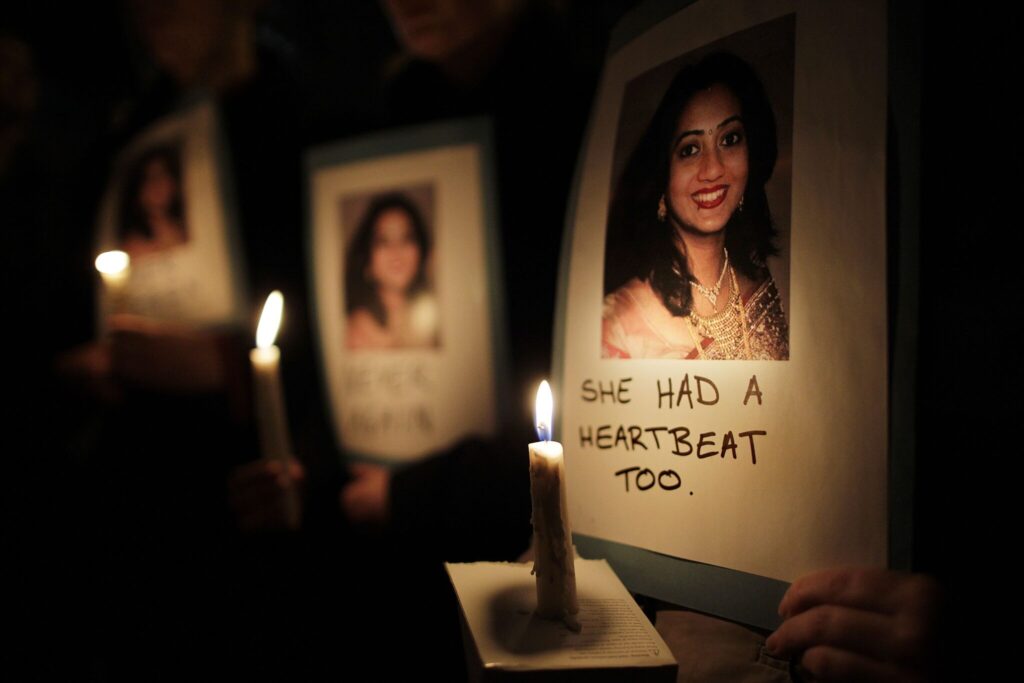Laws that ban abortion at fertilization are based on misogynist myths that minimize women’s agency and personhood.

This article originally appeared in the Daily Hampshire Gazette.
Thirteen states across the U.S. now ban abortion at fertilization—the moment when an egg joins with a sperm. Another three states have passed similar bans currently blocked by courts. Many of these laws have no exceptions for pregnancies resulting from rape or incest, or those that threaten the health of the pregnant women.
To justify these bans, anti-abortion advocates and lawmakers argue that “human life” begins at fertilization. To avoid the obviously religious nature of this position—and the legal problem of establishing as law a particular religious viewpoint with which many disagree—anti-abortion advocates now claim the idea that life begins at conception—which they call “fetal personhood”—is a scientific fact.
This view is not science, says Swarthmore biology professor Stephen F. Gilbert in a recently-published article in Natural Science. “Those people who invoke the scientific community to justify the idea that fertilization is the unequivocal moment of independent identity for the human embryo are expressing mythological and political ideas, not contemporary scientific facts.”
Professor Gilbert explains that there is no consensus among biologists and embryologists about “personhood.” Many scientists recognize that “personhood” is not a scientific category at all—that “like race, personhood is defined socially, not biologically.” According to this view, says Gilbert, “there is no biological marker to personhood, and there is no ‘beginning’ to life, because gametes [eggs and sperms] are, themselves, alive. Therefore, to many biologists, personhood is an issue decided on emotions, upbringing, and politics, not science.”
Even among biologists who believe that science has something to say about “personhood,” there is no consensus. Some hold the view that “personhood” begins at conception—when an egg and sperm join to create a new human genome, while others believe it begins at gastrulation, around day 14 of gestation when the embryo can no longer form identical twins. Others believe “personhood” begins with the acquisition of brain activity as determined by the human EEG pattern (electroencephalogram), while others believe that it begins at birth, after a child takes its first breath, which initiates pulmonary circulation.
Whereas the genetic view of “personhood” equates our DNA to our essence—a “secular analog of the soul,” says Gilbert—the neurological view centers on brain activity as determined by an EEG—when the cerebral cortex begins functioning at about 24-28 weeks of gestation, analogous to how the loss of the human EEG pattern is what determines legal death, even if the heart may still be beating.
Gilbert argues the anti-abortion view of “fetal personhood” is based on three misogynist, nonscientific myths. The first myth depicts fertilization as the culmination of a race of male sperm through a passive female environment and equates fertilization with the creation of a new life, over the act of birthing a child. The second myth is the idea of genetic determinism that valorizes DNA at fertilization as the “biological blueprint for a new individual” and downplays plasticity of genes and the environmental influences on how genes come to manifest during gestation and after. The third myth is the idea that the fetus in the womb is an independent autonomous entity within a “nutritive container”—a “seed in the soil”—marginalizing the “joint nature of maternal and fetal physiologies and anatomies.”
Gilbert argues that these “false narratives combine to form a ‘pseudo-embryology’ that influences our thoughts and laws.” Through these misogynist myths, stories of masculine fertilization are valorized as the defining moment of human creation, whereas the feminine work of gestation and birth is diminished and marginalized.
“Fetal personhood” is a religious concept, not a scientific one. “The fetal personhood crusade is a mix of myth, misogyny, and politics,” says Gilbert. “Science should not be a part of it.” State bans on abortion at fertilization are religious laws, not based on science, but based on misogynist myths that minimize women’s agency and personhood.
In his conclusion, Gilbert draws a parallel between today’s pseudoscience of “fetal personhood” used to justify anti-abortion laws and the pseudoscience of eugenics in the early twentieth century used to justify anti-immigration laws and forced sterilization. “We often look back on how eugenics distorted American politics a century ago, how women were being sterilized in the name of science, and we congratulate ourselves, thinking that such distortions could not happen again. They have,” says Gilbert.
Read more:





